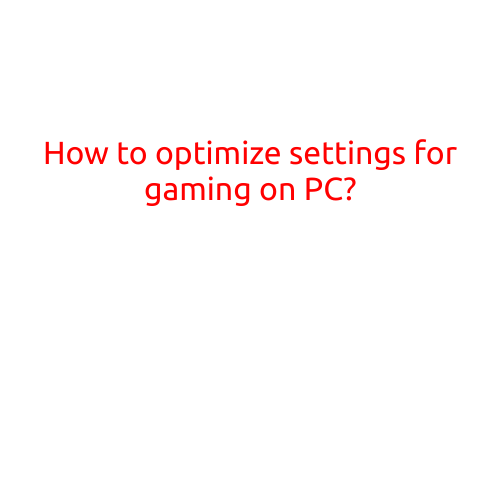
How to Optimize Settings for Gaming on PC
Gaming on a PC can be an exhilarating experience, but only when done optimally. When not optimized, games can become laggy, slow, and frustrating to play. Fortunately, with the right steps, you can optimize your PC’s settings to ensure a seamless gaming experience. In this article, we’ll guide you through the process of optimizing your PC’s settings for gaming.
Step 1: Upgrade Your Hardware (Optional)
Before diving into optimization, consider upgrading your hardware if necessary. Outdated components can hinder your gaming performance. Consider upgrading your graphics card, RAM, or processor to ensure you have the necessary power to run demanding games smoothly.
Step 2: Close Unnecessary Programs
Background programs can consume system resources and slow down your gaming experience. Close all unnecessary programs, including:
- Antivirus software (during gaming, it’s okay to disable it temporarily)
- Chat apps and social media
- Email clients
- Media players
- Unnecessary browser tabs
Step 3: Adjust Your Graphics Settings
Adjusting your graphics settings can have a significant impact on performance. Follow these steps:
- Resolution: Lowering the resolution can improve performance, but it may affect image quality.
- Frame Rate: Cap your frame rate at 60 FPS or lower to prevent excessive GPU usage.
- Graphics Quality: Reduce the graphics quality to trade off visual fidelity for performance.
- Anti-Aliasing: Disable or reduce anti-aliasing to improve performance.
Step 4: Disable Unnecessary Graphics Features
Some graphics features can be demanding on your system. Disable the following:
- Motion Blur: Disables motion blur effect
- Depth of Field: Disables depth of field, which can improve performance
- Shadow Quality: Reduces shadow quality
- Reflection Quality: Reduces reflection quality
Step 5: Adjust Your Audio Settings
Audio settings can also affect performance. Follow these steps:
- Audio Quality: Reduce the audio quality to improve performance
- Audio Buffer Size: Increase the audio buffer size to prevent audio lag
Step 6: Enable VSync
VSync (Vertical Sync) helps reduce screen tearing, but it can also cap your frame rate. Enable VSync to prevent frame rate limiting, but disable it if you prefer a higher frame rate.
Step 7: Monitor Your System Performance
Monitor your system performance during gaming using tools like:
- Task Manager: To monitor CPU, RAM, and GPU usage
- GPU-Z: To monitor GPU usage and temperature
- Frame Rate Monitor: To monitor frame rate and frame time
Step 8: Adjust Your Power Plan
Adjust your power plan to favor performance over battery life:
- High Performance: Set as your default power plan
- Processor Power Management: Disable or reduce processor power consumption
Step 9: Regularly Update Your Drivers
Regularly update your graphics drivers to the latest version to ensure optimal performance.
Step 10: Clean Your PC
Finally, ensure your PC is clean and dust-free to prevent overheating and optimize performance.
By following these steps, you’ll be able to optimize your PC’s settings for gaming, ensuring a smoother, more enjoyable experience. Remember to experiment with different settings to find the perfect balance between performance and visual quality. Happy gaming!





